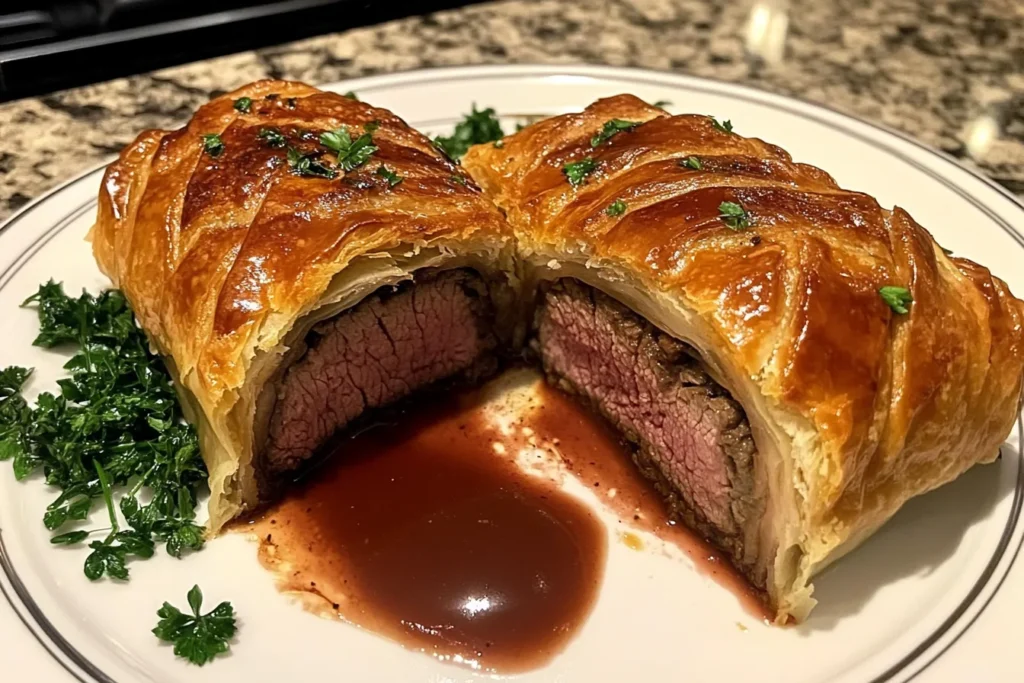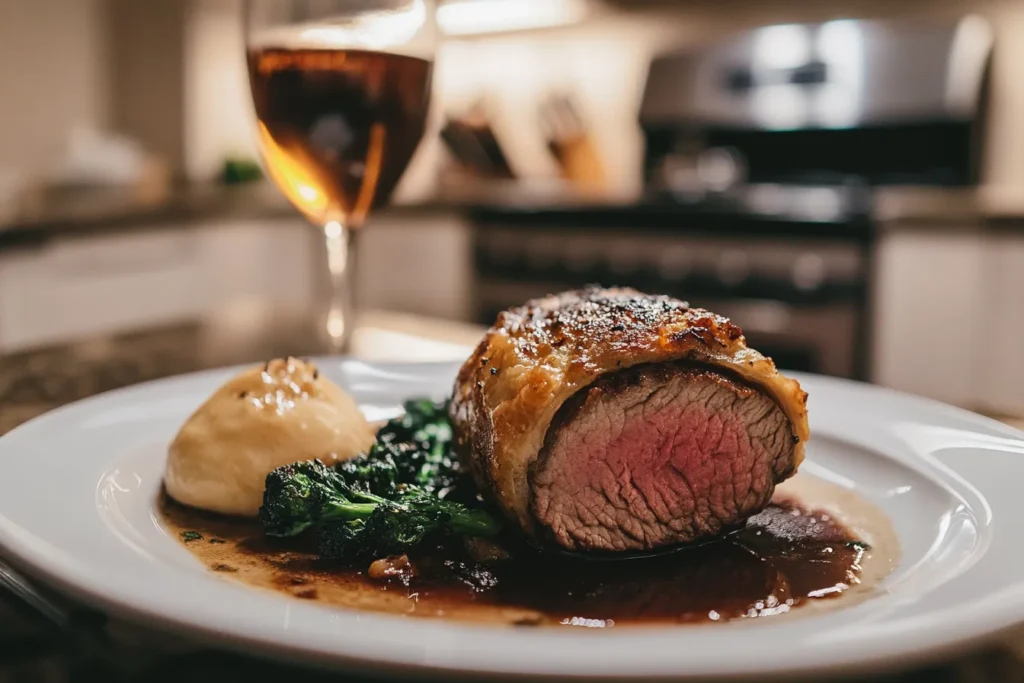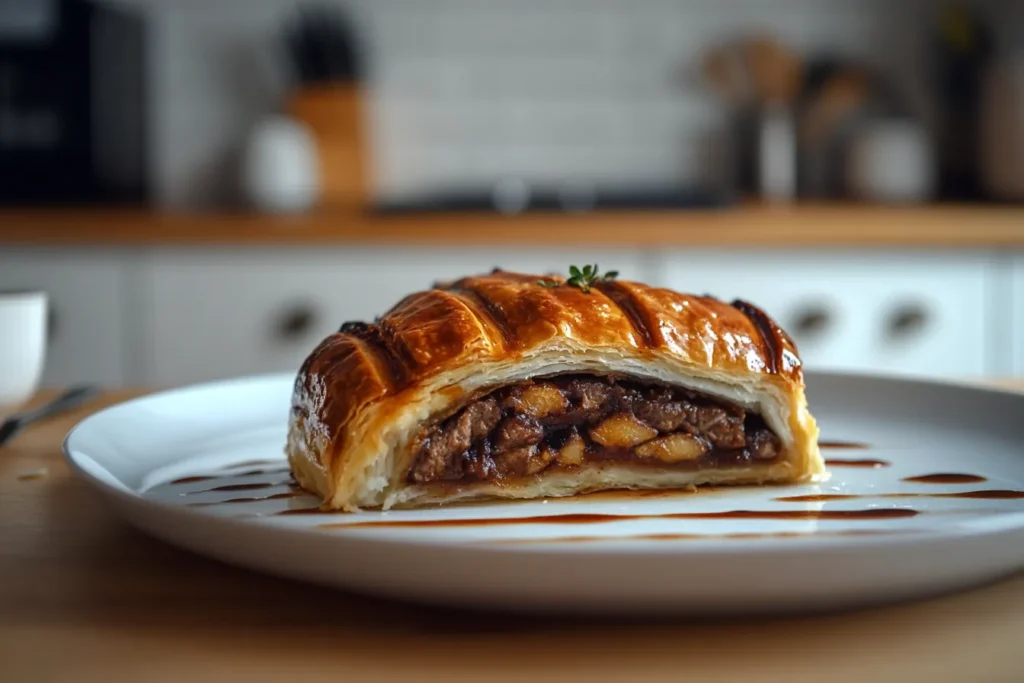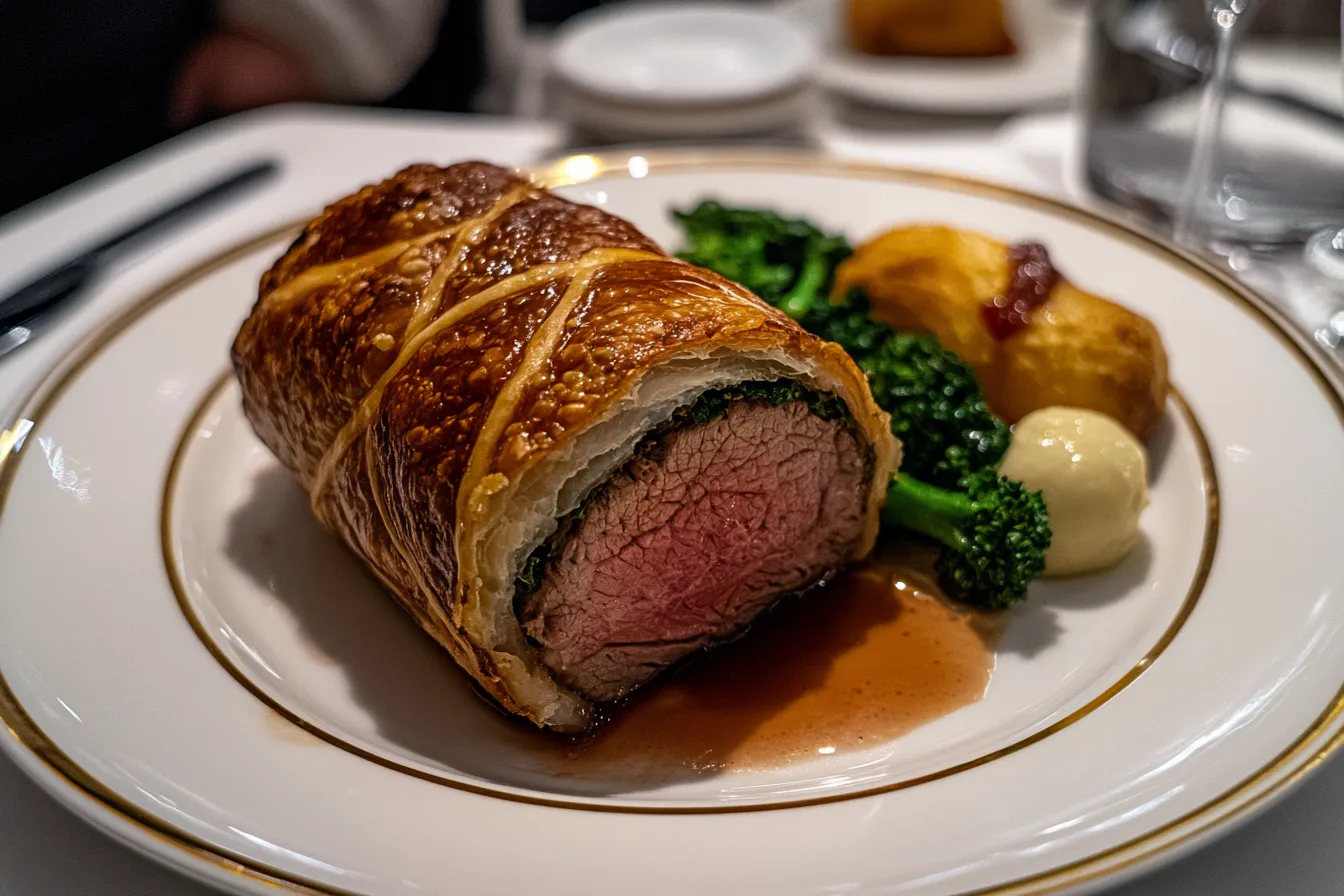So, you’ve decided to tackle Beef Wellington, and now you’re wondering why something so delicious has such a reputation for being tricky. I get it—there’s something intimidating about the layers, the timing, and the pressure to get everything just right. But here’s the thing: you’re not alone in feeling this way. Many home cooks face the challenge of balancing all the components—perfectly cooked beef, a delicate pastry crust, and that rich, flavorful filling. It’s no wonder that Beef Wellington is often considered one of the hardest dishes to master. But don’t worry, with a little guidance and some insider tips, you’ll be able to confidently make this showstopper without the stress. Let’s break it down and show you how to make it easier than you think!
List Of Contents
What Is Beef Wellington?
Beef Wellington is often regarded as a culinary masterpiece, a dish that perfectly balances flavors, textures, and technique. But it’s also one of the most challenging recipes to master. This intricate dish is a test of precision, patience, and skill, making it a go-to for aspiring chefs looking to showcase their talents. Check out more recipes here.
The Origins of Beef Wellington
The history of Beef Wellington is steeped in culinary tradition. Though its exact origin remains debated, many believe it was named after Arthur Wellesley, the 1st Duke of Wellington, a hero of the Napoleonic Wars. This luxurious dish symbolizes British opulence and is a celebration of the Duke’s victory at the Battle of Waterloo.
Some culinary historians argue that Beef Wellington draws inspiration from French cuisine, particularly from filet de bœuf en croûte, which translates to “beef in pastry.” This suggests a fascinating cross-cultural influence that has shaped its preparation. Check out more recipes here.
The Main Components of Beef Wellington
Creating Beef Wellington requires mastering several core elements, each of which plays a pivotal role in its overall success. These components include the puff pastry, beef tenderloin, and duxelles—a finely minced mushroom mixture. Check out more recipes here.
Perfect Puff Pastry: A Delicate Balance
The puff pastry is more than just a vessel for the beef; it’s the crown jewel of the dish. Achieving the perfect puff pastry means balancing flakiness and structural integrity. Too thick, and it overwhelms the beef; too thin, and it won’t hold the filling.
To ensure success:
- Use cold butter for a flaky texture.
- Roll the dough evenly to prevent uneven cooking.
- Chill the pastry after assembly to maintain its shape during baking.
Choosing the Right Beef Tenderloin
The beef tenderloin is undoubtedly the star of the show, as it offers unparalleled tenderness and flavor. Therefore, selecting high-quality beef is absolutely non-negotiable. When choosing the perfect cut, look for several key factors:
- First, ensure the beef has a uniform size to guarantee even cooking throughout.
- Additionally, prioritize cuts with visible marbling, as this enhances the flavor and juiciness.
- Furthermore, freshness is essential to maximize both the texture and taste of the dish.
Finally, proper preparation, such as tying the tenderloin to maintain its shape, is equally critical for achieving a flawless result.o maintain its shape, is equally critical. Check out more recipes here.
Duxelles: The Mushroom Mixture
Duxelles—a blend of finely chopped mushrooms, shallots, and herbs—adds an earthy richness to the dish. This layer brings depth to the flavors while preventing the pastry from becoming soggy by absorbing excess moisture from the beef.
Tips for making perfect duxelles:
- Utilise a food processor to create a uniform and smooth texture.
- Cook the mixture until it’s dry and concentrated.
- Season well to complement the beef.
Balancing Flavors and Textures

A successful Beef Wellington is more than the sum of its parts. It requires careful attention to flavor harmony and texture. From the crispiness of the pastry to the tenderness of the beef and the moisture-locking properties of the duxelles, every element must work in concert.
The Role of Prosciutto or Parma Ham
Wrapping the tenderloin in prosciutto or Parma ham not only adds a salty, savory layer but also serves a practical purpose: it prevents the pastry from becoming soggy. This step is essential for maintaining the structural integrity of the dish. Check out more recipes here.
Techniques Needed for Success
Mastering Beef Wellington requires several advanced cooking skills, particularly when it comes to timing and precision.
Precision in Cooking Temperatures
Achieving perfect doneness for the beef is one of the greatest challenges. Overcooking can dry out the tenderloin, while undercooking may lead to a less-than-ideal dining experience.
Tips for precision:
- Use a meat thermometer for accuracy.
- Sear the beef before wrapping to lock in juices.
- Monitor oven temperatures closely.
Challenges in Preparing Beef Wellington
Creating Beef Wellington is no small feat. It’s a labor of love that demands attention to detail at every stage. From ensuring the beef is perfectly cooked to managing the delicate pastry, there are many challenges that even experienced chefs face.
Maintaining Moisture Without Overcooking
One of the biggest hurdles in preparing Beef Wellington is finding the perfect balance between a juicy tenderloin and a pastry that remains crisp. The beef must be cooked just right—moist and flavorful—without compromising the outer layers of pastry and duxelles.
Strategies for success:
- Sear the beef quickly at high heat to lock in juices.
- Wrap the meat tightly in plastic wrap after searing to retain moisture while it cools.
- Bake at the right temperature to avoid overcooking.
Avoiding Soggy Bottoms

Nothing ruins a Beef Wellington faster than a soggy bottom. This problem arises when moisture from the beef or duxelles seeps into the puff pastry, making it unappetizing and structurally unsound.
Tips to avoid soggy pastry:
- Use a layer of prosciutto to act as a moisture barrier.
- Ensure the duxelles mixture is thoroughly cooked to remove excess water.
- Chill the assembled Wellington before baking to prevent the pastry from softening prematurely.
Layering Without Breaking
The assembly process of Beef Wellington is critical. Each component must be layered correctly and tightly wrapped to maintain its shape during baking. Improper wrapping can result in uneven cooking or a dish that falls apart.
Key steps to proper layering:
- Roll out the puff pastry to the correct thickness, ensuring it’s large enough to wrap the beef completely.
- Use a firm but gentle hand when layering to avoid tearing the pastry or ham.
- Seal the edges of the pastry with an egg wash to secure the structure.
Time Management in Multi-Step Recipes
Beef Wellington is a multi-step recipe that requires impeccable time management. From preparing the components to baking, each stage must be carefully planned to ensure the dish comes together flawlessly.
Best practices for timing:
- Prepare the duxelles and puff pastry in advance to save time on the day of assembly.
- Give the beef time to rest following searing and again after baking to preserve its juices and elevate its overall flavor.
- Coordinate baking with serving time to present the Wellington fresh and warm.
The Role of Resting the Beef Wellington
Resting the Wellington after baking is crucial. This step allows the juices to redistribute within the beef, ensuring every slice is flavorful and moist. It also helps the pastry set, making it easier to slice without crumbling.
Resting guidelines:
- Let the Wellington rest for at least 10–15 minutes after removing it from the oven.
- Tent with foil to retain warmth without trapping steam.
Expert Tips for a Perfect Beef Wellington

While the process is challenging, professional chefs have developed techniques to make this dish more approachable. These tips focus on mastering each component to achieve consistent results.
Secrets to Perfect Puff Pastry
A well-prepared puff pastry is the foundation of a great Beef Wellington. Achieving consistent results requires:
- Keeping all ingredients cold to maintain the pastry’s flakiness.
- Using precise rolling techniques to avoid overworking the dough.
- Brushing the pastry with an egg wash to enhance color and seal edges.
Handling High-Quality Ingredients
The final dish’s success is heavily influenced by the quality of the ingredients used. Investing in top-tier products ensures that each component shines.
What to prioritize:
- Fresh, high-grade beef tenderloin for tenderness.
- Organic mushrooms for robust duxelles flavor.
- Artisan puff pastry, or make your own for an authentic touch.
Testing Doneness Without Cutting
Cutting into the Wellington too soon can ruin its presentation and release valuable juices. Instead, use a meat thermometer to test doneness without disrupting the dish.
Internal temperature guide:
- Rare: 120–125°F
- Medium-rare: 130–135°F
- Medium: 140–145°F
Variations and Modern Twists
Beef Wellington, while steeped in tradition, has inspired countless adaptations. These variations reflect creativity and innovation, making the dish more accessible to different palates and dietary needs. From vegetarian alternatives to bite-sized versions, these modern takes prove that the Wellington can be as versatile as it is elegant.
Vegetarian and Vegan Alternatives
For those seeking plant-based options, creative substitutes can replicate the essence of a classic Beef Wellington without the meat.
Popular alternatives:
- Portobello Mushrooms: These large, meaty mushrooms mimic the texture of beef and pair well with duxelles.
- Seitan or Tofu: Both provide a protein-rich alternative with a neutral flavor base that absorbs seasoning beautifully.
- Vegan Puff Pastry: Many store-bought puff pastries are naturally vegan, making them a convenient choice.
Flavor Enhancements for Vegan Wellingtons
- Use miso or soy sauce to add umami depth.
- Incorporate nuts or grains like quinoa for additional texture.
- A rich vegetable gravy can serve as the perfect complement.
Regional Adaptations of Beef Wellington
Around the world, chefs have reimagined Beef Wellington to incorporate local ingredients and culinary traditions.
Examples:
- Italian Wellington: Featuring prosciutto di Parma and Parmigiano-Reggiano for a Mediterranean twist.
- Japanese Wellington: Incorporating miso-marinated beef and a seaweed layer for umami-rich complexity.
- Indian Wellington: Using spiced lamb or paneer with a puff pastry flavored with cumin and coriander.
Mini Wellingtons: A Party-Friendly Option
Mini Beef Wellingtons offer all the elegance of the original dish in a more manageable, individual-sized portion. These are perfect for parties or events where serving a large Wellington might be impractical.
Advantages of mini versions:
- Faster cooking times.
- Easier portion control.
- Flexibility to experiment with different fillings and flavors.
Tips for preparation:
- Use smaller cuts of beef, such as medallions.
- Adjust baking times to avoid overcooking.
- Experiment with diverse fillings like cheese or vegetables for added variety.
Pairing Beef Wellington with Sides and Drinks
The perfect Beef Wellington meal is enhanced by well-chosen sides and beverages. Thoughtful pairings elevate the dish, complementing its rich flavors and sophisticated presentation.
Choosing the Perfect Wine
Beef Wellington pairs beautifully with full-bodied red wines that can stand up to the dish’s richness.
Top wine choices:
- Cabernet Sauvignon: Bold and tannic, ideal for balancing the richness of the beef and pastry.
- Pinot Noir: A lighter red with earthy undertones that complement the duxelles.
- Merlot: Soft and smooth, offering a subtle contrast to the dish’s complex flavors.
Non-alcoholic options such as sparkling water with a splash of cranberry or pomegranate juice also provide a refreshing contrast.
Best Side Dishes for Beef Wellington
Selecting the right side dishes enhances the Wellington without overpowering it. These accompaniments balance its richness and add variety to the meal.
Popular side dishes:
- Roasted Vegetables: Carrots, parsnips, and brussels sprouts bring vibrant color and natural sweetness.
- Creamy Mashed Potatoes: A classic choice that absorbs the juices from the beef.
- Red Wine Sauce: Adds a luxurious, tangy touch to every bite.
Troubleshooting Common Issues
Despite meticulous preparation, things can go wrong when making Beef Wellington. Knowing how to address these issues ensures your dish is salvageable.
Salvaging Soggy Pastry
If the pastry turns out soggy, there are ways to recover the dish:
- Place the Wellington back in the oven on a higher rack to crisp the pastry.
- Use a pizza stone during baking to promote even heat distribution.
- Avoid serving the bottom layer by presenting pre-sliced portions.
Preventing Overcooked Beef
Overcooking the beef is a common fear. To avoid this:
- Always use a thermometer to monitor internal temperature.
- Remove the Wellington from the oven 5–10°F before the target temperature to allow carryover cooking.
- Rest the Wellington appropriately to preserve its juices.
Conclusion: Mastering Beef Wellington
Beef Wellington may be a challenging dish, but it’s also one of the most rewarding to prepare. By focusing on technique, high-quality ingredients, and timing, you can conquer this culinary icon. Whether you stick to tradition or explore modern variations, mastering Beef Wellington is a true testament to your skills in the kitchen.
FAQ
- Can I make Beef Wellington ahead of time?
Yes, you can prepare and assemble it in advance, but bake it fresh to ensure the pastry stays crisp. - What’s the best way to reheat leftovers?
Reheat slices in the oven at 300°F to maintain texture and flavor. - Can I freeze Beef Wellington?
Yes, freeze it before baking.Bake it straight from frozen, ensuring you adjust the cooking time accordingly to achieve the desired doneness. - Why is my puff pastry not rising properly?
Ensure the dough is cold before baking and avoid overworking it during rolling. - What can I use instead of prosciutto?
Try bacon, turkey ham, or omit it entirely for a lighter version. - How do I prevent my beef from shrinking?
Allow the beef to rest after searing to relax the muscle fibers. - Do I have to use beef tenderloin?
While tenderloin is traditional, other cuts like sirloin can work if properly prepared. - How do I keep the pastry golden?
Apply an egg wash evenly before baking. - Can I use store-bought pastry?
Absolutely! High-quality store-bought puff pastry saves time and yields excellent results. - Is Beef Wellington gluten-free?
It can be made gluten-free by using gluten-free pastry and ensuring all other ingredients are safe.
